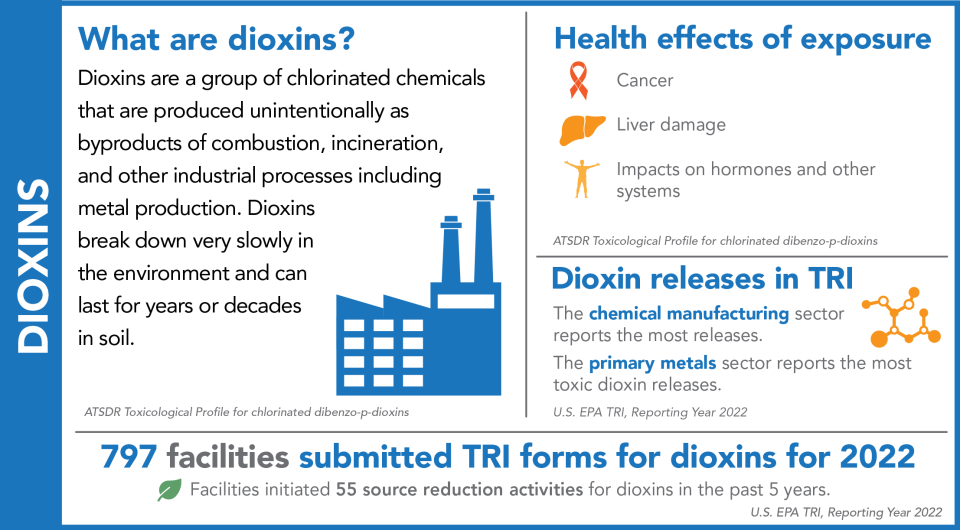Dioxins
This chemical profile focuses on releases of dioxin and dioxin-like compounds.

Dioxin and dioxin-like compounds (“dioxins”) are a group of chemically-similar compounds that are typically produced in very small quantities but are toxic at much lower concentrations than most other chemicals. Additionally, they persist in the environment and bioaccumulate in the food chain. Dioxins have a lower reporting threshold and are reported in grams instead of pounds to capture smaller amounts of these chemicals.
This map shows the locations of the facilities that reported dioxins to TRI for 2022, sized by their relative release quantities. Zoom in to view demographic data for communities around these facilities. Click on a facility for more details on its reporting.
Click on any one of the locations on the map to see detailed information.
View Larger Map
TRI requires facilities to report data on the 17 individual members of the TRI dioxin and dioxin-like compounds category. While each chemical in the dioxin and dioxin-like compounds category causes the same toxic effects, some cause these effects at lower levels of exposure than others because the chemicals have different toxicities. As a result, one mixture of dioxins can have a very different toxic potency than the same amount of a different mixture. Facilities in different sectors tend to release different mixtures of dioxins depending on their operations, so the potential for harm from their releases may also be different.
EPA accounts for the varying toxicities of the different dioxins by using Toxic Equivalent Factor (TEF) and Toxic Equivalency (TEQ) values. TEFs help to understand the toxic potency of each dioxin. TEFs are then used to derive TEQs, which add context to releases of different mixtures of dioxins. TEQs are most useful when comparing releases of dioxins from different sources or different time periods, where the mix of congeners may vary.
Toxic Equivalent Factor (TEF)
Each individual dioxin is assigned a TEF that compares that compound’s toxicity to the most toxic dioxin in the category.
Toxic Equivalency (TEQ)
A TEQ is calculated by multiplying the reported grams of each compound by its corresponding TEF and summing the results, referred to as grams-TEQ.
Learn more about dioxins at EPA’s Dioxins homepage and ATSDR’s dioxins ToxFAQs.
This graph shows the 10-year trend in the quantity of dioxins that facilities released from 2013 to 2022.
From 2013 to 2022:
- Dioxin releases fluctuated over the last ten years, with a decrease of 11% between 2013 and 2022. Toxicity equivalents (grams-TEQ) decreased by 24%, indicating that the overall toxicity of dioxin releases decreased even more than the quantity released. This is due to changes in which dioxin congeners were released.
From 2021 to 2022:
- Grams released of dioxins decreased by 23%, driven by decreased releases reported by an organic chemical manufacturing facility.
- Toxicity equivalents (grams-TEQ) decreased by 18%, similar to the decrease in grams released.
- In 2022, 55% of dioxin releases were disposed of at off-site locations, primarily in landfills.
Dioxins Releases by Industry
The following two pie charts compare the industry sectors that reported the greatest releases of dioxins (in grams) to those that reported the greatest releases of dioxins based on toxicity equivalency (in grams-TEQ).
- The mix of dioxins released varies across industry sectors.
- The chemical manufacturing industry accounted for 70% and the primary metals sector for 9% of total grams of dioxins released. In terms of toxicity equivalents, however, the primary metals sector accounted for 49% and the chemical manufacturing sector for 26% of the total grams-TEQ.
This page was published in March 2024 and uses the 2022 TRI National Analysis dataset made public in TRI Explorer in October 2023.
